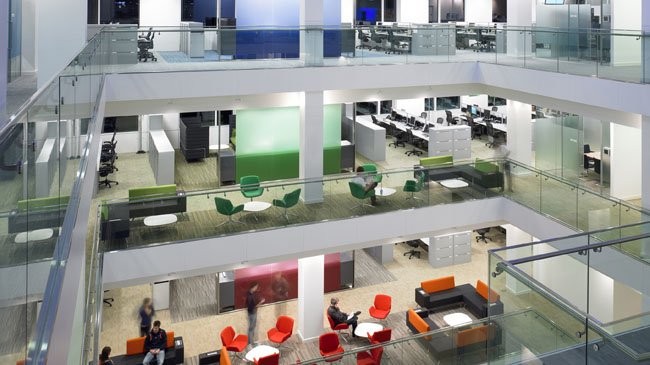
We spend a lot of time and effort debating and researching how to design the perfect office - perhaps too much time, according to Rachel Casanova, a Principle and Director of Workplace at Perkins + Will. In this post, originally published by Metropolis Magazine as "When the Open Office Isn't Always the Problem or Solution", Casanova argues that we ought to be thinking about office design more holistically, taking into account not just the physical space of the office, but also how the client runs their workplace. At best, design can catalyse a more nurturing office environment, but for each company the way to achieve this may be different; there is no 'one-size-fits-all' office solution. Read on after the break to find out why.
The open-plan office hasn’t had a good year. Recent criticisms have linked open workspaces to declining levels of individual productivity and satisfaction for workers. Critics and columnists complained about noise, about the lack of privacy, about the dreadful uniformity. Yet, in the last decade, the open office has evolved by leaps and bounds. Silicon Valley popularized the casual workplace, embellishing the open plan with pockets of hangout space and social zones. Today’s office systems incorporate much more choice, offering numerous configurations of collaborative space, community space, and integrated technology that make it easy for workers to tailor their workplace to their liking.
But, my aim is not to argue for or against the open office. Instead, I want to shift the conversation to the macro-level, asking how space can work regardless of the strategy deployed. Despite the op-ed pieces and baiting headlines, our clients have reported increased engagement, better communication, and greater accessibility of leadership—benefits which they attribute to their work environment. The open office has been associated with healthier workplaces, greater access to natural light and views, and overall satisfaction with work. Even so, I don’t think that credit or blame should ever be attributed solely to the physical layout or design of a workplace.
But what if the complaints about the office are misplaced? Maybe the workplace is just a symptom, and not the root of the problem. Let’s explore a more holistic view by considering the nature of work today. The speed at which things are happening, for better or worse, is accelerating. Companies are changing how they do business, from the way they develop products and engage with clients and consumers to the way they conduct research and maintain brand perception. Furthermore, the physical ties to the workplace are dissolving; many employees can and often do portions of their work with a simple Internet connection and a laptop or tablet.
If an office is designed well and reinforces expected behaviors, it will signal helpful cues to support organizational changes that have not been fully adopted. However, while design can enable change, it cannot lead it. When workplace design conflicts with existing behaviors, the opposite reaction occurs. In that case, design inhibits adoption. Space, and often the architecture that frames it, becomes the articulated problem—the scapegoat. This makes sense—the built environment is visual, it’s tactile, it’s malleable, and it’s easy to critique.

Think of examples where leadership’s message and management’s action don’t reinforce each other. Or the roll out of team-based goals which are undermined by individual reward structures. Apropos to space—we frequently hear that company policy supports remote work, but managers take punitive actions against those that participate. When these latent issues that have created misalignment become exposed, the design of the office is the target.
It’s no wonder that two recent studies found that employee engagement is at a dramatic low point. Gallup reports that only 30% of people in full-time jobs are engaged and inspired at work. Similarly, a Towers Watson study has 40% of workers reporting that they are unsupported or detached, and another 25% admitted to feeling completely disengaged.
When this much change and stress exists within today’s work environments, office design may not be the culprit (nor the savior, admittedly). Nevertheless, it’s what gets the bad rap. In the best of cases, a change to the physical space can be the catalyst that forces other changes to be adopted. Therefore, our opportunity and responsibility is to ensure that a workspace can contribute to a high-performance organization.
Consider the following tenets the next time you are considering an office redesign:
- Leadership messaging and connection to the business’s priorities is a must.
- Management understanding and active engagement are critical.
- Understand the difference between official processes and the way ‘things really get done’
- Change should be aligned—assess business processes, technology, culture, and human resource strategies in relation to the intended space change. Understand the impact that space will have.
- Focus on universal adoption of these other business changes before a workspace is redesigned. When that’s not possible, use the design and construction cycle to focus on adoption before moving into a new environment.
- Find early adopters who have already mastered the pending changes. Find out how and why it’s working for them and share widely within the organization! Allow them to continue to evolve, don’t hold them back.
- 3 E’s—educate, engage, and enable employees to change. Commit to transparent communication and opportunities for employees to participate in the change, and invest in training in order to make the ‘new’ way more compelling than the old one.
Yes, good design matters; it can support employee engagement, productivity, and connection to a company’s business and social responsibility goals. But it’s not the only catalyst to change, and it doesn’t exist in a vacuum. Let’s take a less extreme view and stop making the open office a punch line. And let’s face it, there are plenty of better workplace jokes.
Rachel Casanova is a Principal and Director of Workplace at Perkins + Will, along with serving as a judge for the Workplace of the Future 2.0 Design Competition.

